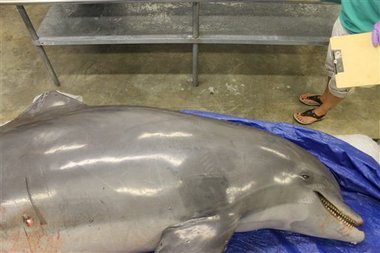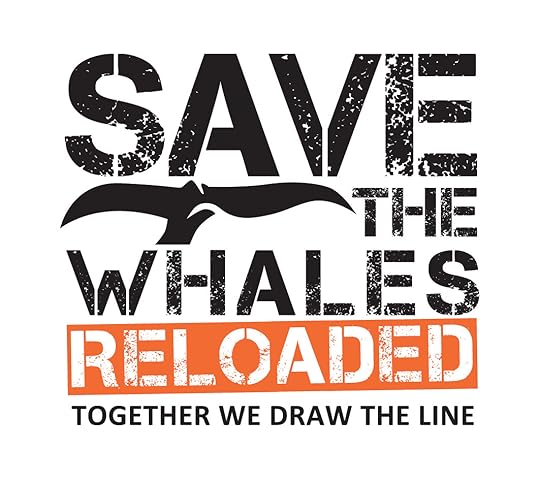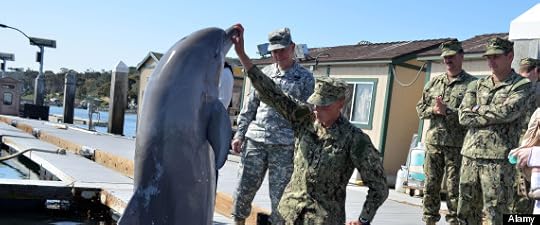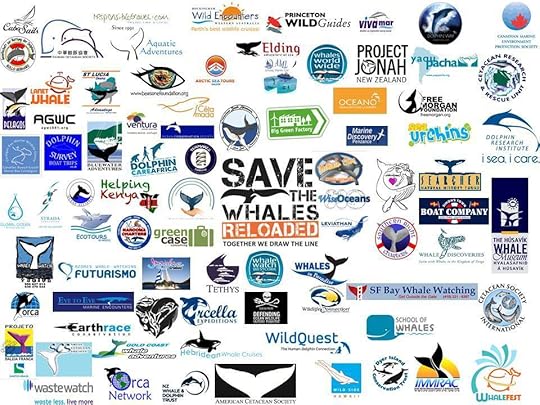Mark Caney's Blog, page 40
November 21, 2012
Rewards offered for Gulf of Mexico dolphin killer
 After news of a series of Gulf of Mexico dolphin attacks that have included bullet wounds, a missing jaw and a hacked-off fin, Paul Watson, star of the Animal Planet series Whale Wars, announced on Tuesday evening that he is offering $20,000 of his own money for information leading to the arrest and conviction of the person or persons responsible. The California-based Animal Legal Defense Fund already has offered a $5,000 reward.
After news of a series of Gulf of Mexico dolphin attacks that have included bullet wounds, a missing jaw and a hacked-off fin, Paul Watson, star of the Animal Planet series Whale Wars, announced on Tuesday evening that he is offering $20,000 of his own money for information leading to the arrest and conviction of the person or persons responsible. The California-based Animal Legal Defense Fund already has offered a $5,000 reward.
“I regard the killing of a dolphin as murder, and what we appear to have on the Gulf Coast is a dolphin serial killer,” said Watson, a co-founder of Greenpeace. “I want this sadistic killer stopped.”
Watson leads the global marine nonprofit conservation organization Sea Shepherd Conservation Society, which he founded in 1977. It’s mission is “to end the destruction of habitat and slaughter of wildlife in the world’s oceans in order to conserve and protect ecosystems and species.”
In the most recently reported dolphin fatality, on Friday, scientists from the Institute for Marine Mammal Studies in Gulfport found a dolphin near Deer Island with its lower jaw missing. On Monday, National Oceanic and Atmospheric Administration officials asked people to be on the lookout for injured or dead dolphins, and any unusual human interactions with dolphins, and call the NOAA Enforcement hotline at 800.853.1964 to make a report.
It’s yet another in a recent spate of intentional attacks on dolphins in the Gulf of Mexico. In September, a bottlenose dolphin was fatally shot and found dead in Louisiana on Elmer’s Island near Grand Isle.
And earlier this year, a dolphin off Alabama was found with a screwdriver stuck in its head. During the past several years, Gulf fishers have been convicted of shooting dolphins, or targeting them with pipe bombs.
Full story: Nola.com

November 20, 2012
Violent dolphin deaths a mystery in US
Over the past several months, dolphins have washed ashore along the northern Gulf Coast with bullet wounds, missing jaws and hacked off fins, and federal officials said they are looking into the mysterious deaths.
The most recent case was of a dolphin found dead off the coast of Mississippi, its lower jaw missing.
Officials from the National Oceanic and Atmospheric Administration said Monday they’re asking everyone from beachgoers to fishermen to wildlife agents to be on the lookout for injured or dead dolphins – and any unusual interaction between the mammals and people.
“It’s very sad to think that anyone could do that to any animal,” said Erin Fougeres, a marine mammal scientist for NOAA’s southeast office in St. Petersburg, Fla. “There have been some obviously intentional cases.”
Fougeres said five dolphins have been found shot. In Louisiana, two were shot in 2011 and one in 2012. And in Mississippi, three were found shot this year, the most recent one last week, which was first reported by the Sun-Herald newspaper.
Besides the shootings, a dolphin in Alabama was found with a screwdriver stuck in its head over the summer. Another in Alabama had its tail cut off, and that animal survived. Still others were missing fins or had cuts to their bodies.
“I think it is outrageous,” said Moby Solangi, the executive director of Institute for Marine Mammal Studies in Gulfport, Miss. “These animals are very docile, very friendly and they’re very curious. They come close to the boats, so if you’re out there, you’ll see them riding the bows. And their curiosity and friendship brings them so close that they become targets and that’s the unfortunate thing.”
Dolphins are among the species protected by the 1972 Marine Mammal Protection Act. Violators can be fined up to $10,000 per violation and sent to prison for a year.
The California-based Animal Legal Defense Fund said it is offering a $5,000 reward for information leading to the arrest and conviction of whomever harmed the dolphins.
The gruesome discoveries are heartbreaking for Gulf Coast scientists, who follow the population. Fougeres said that two months before the 2010 oil spill disaster off the coast of Louisiana, dolphins began stranding themselves and that there were unusually high mortality rates – possibly due to a cold winter that year.
Since then, the spill and another cold winter in 2011 have contributed to several deaths within the Gulf’s dolphin population, experts say. Investigators have also found discolored teeth and lung infections within some of the dead dolphins.
Since Feb. 2010, experts have tallied more than 700 recorded dolphin deaths.
Experts have also found increased “human interaction” cases, which include dolphins tangled in fishing lines – and the more violent incidents.
Fougeres cautions that some of the dolphin mutilations might have happened after the animal died from natural causes and washed ashore. She said that in the case of the dolphin with the lower jaw missing, someone could have cut off the jaw for a souvenir after the animal died.
“We have to do a necropsy on the animal and collect tissue samples to try to determine whether or not the injury was pre-or post-mortem” she said.
She also said that the increase in cases might be due to NOAA’s dolphin stranding network becoming better trained to notice cruelty cases or unusual deaths.
Some have suggested that the deaths are the work of a few angry fishermen who are upset about bait-stealing dolphins. Yet the majority of fishermen say that while dolphins can be annoying, they wouldn’t harm the creatures.
Full story: NBC29 by TAMARA LUSH

November 14, 2012
Last chance to enter the competition – it ends at midnight!
Goodreads Book Giveaway

Dolphin Way
by Mark Caney
Giveaway ends November 15, 2012.
See the giveaway details
at Goodreads.

November 13, 2012
‘Save the Whales: Reloaded’ forms new global community
 A new global community has been formed to protect whales and dolphins across the world’s oceans.
A new global community has been formed to protect whales and dolphins across the world’s oceans.
The alliance was announced following the World Whale Conference held at the end of October at the Hilton Brighton Metropole, Brighton, UK, the hotel where the original moratorium on whaling was signed in 1982.
Mark Caney with Dolphin Way joined over 75 leading environmental and animal protection groups and businesses committing to Save the Whales: Reloaded. The new global alliance will identify and work together to protect whales and dolphins in all of the places where they most need help.
The news was announced by whale and dolphin specialists Planet Whale which orchestrated the alliance, with environmentalists including Bill Oddie and Jean Michel Cousteau already flagging up sites requiring urgent action. Dylan Walker, co-founder of Planet Whale commented:
“Today marks an historic move forward as we galvanise the passion and commitment of the original Save the Whales campaign with Save the Whales: Reloaded. As an active and influential global community we will be using our collective energy and expertise to identify and ring fence new ‘Areas of Concern’ for whales and dolphins across the globe. Today, we are naming the first three areas we have agreed to tackle and we are already planning to announce thousands more as we seek to ensure the long term protection of all whales, dolphins and porpoises, collectively known as cetaceans.”
Identifying key locations where whales and dolphins are currently under threat, the alliance has announced the first three sites targeted for immediate action. These are:
The Southern Ocean Whale Sanctuary[i]
Whale and Dolphin Conservation (WDC), Canadian Marine Environment Protection Society, and Cetacean Society International have come together with some 20 other NGO and business supporters from around the world to re-affirm the need for whaling to end in the Southern Ocean Sanctuary and to make it a true sanctuary for whales.
The call came in a week when the world’s eyes were trained on the Southern Ocean where, in Hobart, Australia, the fate of the proposed 2.4 million km2 Ross Sea Region Marine Reserve and Antarctic reserve network was being decided by CCAMLR — the Commission for the Conservation of Antarctic Living Marine Resources.
Says Erich Hoyt, Whale and Dolphin Conservation (WDC) Research Fellow and author of Marine Protected Areas for Whales, Dolphins and Porpoises: “We are calling on every country to make this commitment to whales and the marine ecosystem, stop all fishing there, and to give the strongest possible message for conservation in the global commons and high seas of the great Southern Ocean. This is our big chance; we can’t blow it.”
Save the Whales: Reloaded supporters will campaign against the ongoing slaughter of whales within the sanctuary by the Japanese whaling fleet, and for the creation of an Antarctic reserve network.
New Zealand’s Coastal Waters[ii]
Twenty two conservation groups and businesses from around the world have joined NABU International in a collective bid to save the Maui and Hector’s dolphins as part of the Save the Whales: Reloaded campaign.
Maui and Hector’s dolphins are the smallest and rarest marine dolphins on earth and live only in New Zealand. Over the past four decades, gillnetting and trawling have decimated them almost to the point of extinction. A ban on gill and trawl nets across the species’ full range in all waters up to 100m deep is crucial if these dolphins are to recover.
“Saving Hector’s and Maui’s dolphins is a race against time. They simply can’t hang on much longer and need action now,” says Dr Barbara Maas, Head of International Species Conservation at NABU International.
“We stand together and call on the New Zealand government to protect Hector‘s and Maui‘s dolphins immediately and fully against harmful fishing methods before it’s too late. If New Zealand fails on this critical conservation challenge, it will damage the country’s reputation forever.”
Save the Whales: Reloaded supporters will petition the New Zealand government to increase the ban on trawling and set nets along the coastline to extend to the species’ full range.
Loro Parque, Tenerife[iii]
Captured two years ago, wild orca Morgan languishes in Loro Parque, a privately owned entertainment park in the Canary Islands. Now, forty seven charities, businesses and delegates at the World Whale Conference have added their support to the Free Morgan Foundation to save Morgan from captivity as part of the Save the Whales: Reloaded campaign.
Morgan has been subjected to attacks and bullying from other orca and is showing signs of severe stress and abnormal behaviours as a result of being subjected to inhumane conditions.
Dr Ingrid Visser of the Free Morgan Foundation, who has studied wild and captive orca for more than 20 years said: “Morgan is a prime candidate for rehabilitation and release, the only thing that is stopping her return is the money-focused greed of the captivity industry. Morgan represents all that is wrong with this industry, which claims that keeping these animals is a form of education. I’ve never heard a word of education out of there yet and all we are teaching is that is ok to abuse animals.”
Save the Whales: Reloaded supporters will join the Free Morgan Foundation in campaigning for a boycott of the park and the release of Morgan back to the wild.
The global community behind Save the Whales: Reloaded was formed at last week’s World Whale Conference which brought together members of the public, whale and dolphin charities, government agencies and businesses from around the world to share ideas and best practice. A total of 44 charities and 34 whale watching businesses have committed to Save the Whales: Reloaded, representing 27 countries from every continent apart from Antartica.
“Despite the vote in 1982, the world’s whales have not been saved and they are still not safe,” continued Dylan Walker of Planet Whale. “Whilst whaling is much reduced, it still remains, and these beautiful creatures are also losing ground to a whole plethora of destructive issues, including over-fishing and drowning in nets, pollution, habitat destruction, climate change and being held captive for entertainment in aquariums. As a community we are committed to our cause and our message today to all those involved in cruelty towards cetaceans and destruction of their natural habitats is clear: we will not stop until you stop.”
Planet Whale is also inviting the public to support Save the Whales: Reloaded and help identify the next generation of Marine Protected Areas. Visitors to last weekend’s WhaleFest 2012 event in Brighton mapped out an astonishing 1,000 areas of the oceans which they would like to see ring fenced for the protection of wild whale and dolphin communities. Created using an innovative free online mapping tool, these maps will be combined with others drawn by people across the globe to ensure members of the public, governments, charities and other stakeholders all have a say in the future protection of the oceans.
[i] The Southern Ocean Whale Sanctuary
The Southern Ocean Sanctuary was adopted by the International Whaling Commission in 1994 to provide long-term protection for a substantial portion of the world’s remaining whales by protecting their feeding grounds, yet today more whales are hunted here by the Japanese whaling fleet than in any other location on Earth.
Says Erich Hoyt, WDC Research Fellow and author of Marine Protected Areas for Whales, Dolphins and Porpoises: “This area has three ecotypes of Killer Whales, Minke and other whales, penguins, seals and seabirds in one of the most productive ecosystems on Earth.”
Last week the world’s eyes were trained on the Southern Ocean where, in Hobart, Australia, the fate of the proposed 2.4 million km2 Ross Sea Region Marine Reserve and Antarctic reserve network was being decided. Every country member of CCAMLR — the Commission for the Conservation of Antarctic Living Marine Resources, the body charged with setting up marine reserves in Antarctic waters — needed to agree to make that happen but they failed to do so.
[ii] New Zealand’s coastal waters
Since 1970 Hector’s dolphin numbers have dropped by more than three quarters. Maui’s dolphins, a subspecies of Hector’s dolphins off New Zealand‘s North Island, have been decimated to around 55 individuals and are facing imminent extinction.
At current population levels, Maui’s dolphins can only cope with one death due to human activities every 10-23 years, but around five Maui’s dolphins die in fishing nets each year. That’s 75 times more than the sustainable limit.
“Saving Hector’s and Maui’s dolphins is a race against time. They simply can’t hang on much longer and need action now,” says Dr Barbara Maas, Head of International Species Conservation at NABU International. “The New Zealand government is refusing to afford Maui’s and Hector’s dolphins the necessary protection. Current and newly proposed protection measures are not nearly enough to allow them to recover.”
The world‘s largest conservation assembly, the IUCN World Conservation Congress recently passed a motion that urges New Zealand to extend protection of Maui‘s and Hector‘s dolphins against gillnetting and trawling to a depth of 100 meters offshore to include their entire range. The motion was adopted with 117 governmental and 459 NGO votes in favour. New Zealand alone voted against it.
“Scientists are optimistic that Maui’s can recover if human induced mortality is eliminated”, says Maas. “In line with the IUCN World Conservation Congress’s recommendations, we stand together and call on the New Zealand government to protect Hector‘s and Maui‘s dolphins immediately and fully against harmful fishing methods before it’s too late. If New Zealand fails on this critical conservation challenge, it will damage the country’s reputation forever.”
The New Zealand government has opened a public consultation on the protection of the last 55 Maui’s dolphins which runs until 22November. This process gives everyone the opportunity to have their say by sending a submission through the website www.hectorsdolphins.com.
[iii] Loro Parque, Tenerife
Forty seven charities, businesses and delegates at the World Whale Conference have now added their support to the Free Morgan Foundation to save a wild orca from captivity as part of the Save the Whales: Reloaded campaign.
Alone and starving, this young female wild orca was recently taken into captivity. Now called Morgan, she has been subjected to attacks and bullying from other orca. Morgan is showing signs of severe stress and abnormal behaviours as a result of being subjected to inhumane conditions. Originally captured under the guise of rehabilitation and release, she is being kept because the entertainment industry desperately needs a new blood line for their extremely inbred captive orca population.
Held at the entertainment Park, Loro Parque, in the Canary Islands, Spain, Morgan is made to perform circus tricks for a paying audience. Yet between shows trainers neglect and ignore her and just standby whilst the other orca attack her. Morgan is not provided veterinarian care for her resulting wounds.
More than 5,500 whales and dolphins have died in captivity. In the wild, the average age for orca is more than 30 years with some orca known to live well past 80, however, in captivity the average life span is less than 9 years. Morgan has been in captivity for just over two years, but she has spent more of her life in the open ocean than in a tank. There is a comprehensive release plan in place to help Morgan return to her family in Norway.

November 12, 2012
US Navy Replaces Dolphins With Robots
 The US Navy is reportedly planning to replace its last military dolphins with robots.
The US Navy is reportedly planning to replace its last military dolphins with robots.
In an exclusive interview with BBC Future, the navy said it would replace its highly trained pod of sea mammals with cheaper electronic alternatives.
The Navy has used dolphins in missions to help locate and even destroy mines at sea for more than 50 years.
The program was started in 1960, and also used sea lions, sharks and 16 other species. Bottlenose dolphins were chosen because of their sonar, high intelligence and underwater vision.
Now the practice will be phased out from 2017, because a new line of robotic mine hunters is cheaper and more effective, said Captain Frank Linkous, head of the US Navy’s Mine Warfare Branch.
The new generation of 7-metre-long underwater vehicles were first unveiled in April, and will be slowly phased in when they are ready.
BBC Future has the full story at its website (not accessible in the UK).
The Navy has always said that it treats its military animals with utmost care, and likens their use to that of security patrol dogs, whose sense of smell is superior to humans and many machines.
It has been criticised in the past, particularly. by animal rights groups, but says it is subject to the same laws and regulations as any organisation.
The service says on its website: “Just as the dog’s keen sense of smell makes it ideal for detecting land mines, the U.S. Navy has found that the biological sonar of dolphins, called echolocation, makes them uniquely effective at locating sea mines so they can be avoided or removed.”
Full story: Huffpost Tech

Dawn to Death — The dolphin slaughter in Taiji
A newly released video by sound recordist Martyn Stewart captures the Taiji dolphin drive like never before. Compiled from footage taken over three years, the film offers a gut-wrenching view of the six-month-long slaughter.
Read Elizabeth Batt’s report here: Digital Journal

November 11, 2012
China surveys Yangtze dolphin as extinction looms
Chinese scientists on Sunday began a survey of the dwindling population of an endangered porpoise in the country’s longest river, as the animal edges towards extinction from man-made threats.
Researchers will spend more than a month tracking the finless porpoise — known as the “river pig” in Chinese — in the Yangtze River, China’s longest waterway at more than 6,000 kilometres (3,700 miles), organizers said.
It marks the most comprehensive survey of the species, found only in China, since 2006, when a similar expedition found only 1,800. The current number could be far lower, they said.
“Our expectation is maybe only 1,000 of them are left, but we have to see how it turns out from the survey,” said Wang Ding, a research professor at the Institute of Hydrobiology under the Chinese Academy of Sciences.
“People have started to think of the finless porpoise as the symbol of the Yangtze River which also indicates the current status of the river,” Wang, who is leading the expedition, told AFP.
The earlier 2006 expedition declared another species, a freshwater dolphin called the “Baiji”, to be extinct.
The finless porpoise, which has only a small dorsal ridge rather than a fin, has been hurt by human intrusion and environmental degradation, said global conservation organisation WWF, which is supporting the expedition.
Deaths of the creature have been caused by boat strikes and fishing gear accidents as well as degradation of rivers — and dolphin food sources — due to pollution and severe droughts blamed on climate change.
“If we are going to save the Yangtze finless porpoise… we must take immediate action to keep the Yangtze River and its lakes healthy,” Lei Gang, director of WWF China’s freshwater programme, said in a statement.
“This means better laws and enforcement — we need to see harmful fishing practices stop, sand-dredging better controlled and new reserves developed.”
The WWF has said the porpoise could become extinct in 15 years if no action is taken.
Waterways in China have become heavily contaminated with toxic waste from factories and farms — pollution blamed on more than three decades of rapid economic growth and lax enforcement of environmental protection laws.
Environmental activists have also blamed China’s huge Three Gorges Dam and other hydropower projects on the Yangtze for upsetting the delicate ecological balance and harming aquatic life in the river.
The government-backed expedition set sail Sunday from the central Chinese city of Wuhan aboard two boats equipped with sonar and acoustic surveying equipment, organisers said.
They will travel upstream to Yichang, gateway to the Three Gorges Dam, before heading back downstream all the way to China’s commercial hub of Shanghai at the mouth of the Yangtze, they said.
Source: Times of India

November 7, 2012
Stranded dolphins rescued
Two dolphins stranded in shallow water off the coast of Shanghai’s Chongming Island were freed yesterday into the Yangtze River.
One dolphin about two meters long and weighing 150 kilograms was found stranded in the waters of Beibao Port on Tuesday night. The other dolphin measuring about 1.6 meters was seen trying to help the other’s head up by nudging it, witnesses said.
It failed and also became stranded as the tide fell. It made a whining sound, witnesses said.
Police said the dolphins, a male and a female, were struggling when they arrived. They approached the dolphins with a small boat and tried to drag them into deeper water but failed because of the ebbing tide.
Police splashed water onto them and cleaned the sludge from their noses to keep them alive.
They finally used bed sheets and foam boards to wrap up the dolphins and moved them onto the shore with the help of more than 10 fishermen.
The dolphins were then transported to a small river nearby.
Yesterday, they were transported on boats to the Yangtze River and released, said an official surnamed Qian with the Chongming County fishing governance authorities.
The dolphins likely came from the East China Sea and got lost, said Qian.
Source:Shanghai Daily

November 6, 2012
Whale who tried to speak like a human
A Beluga whale named Noc learned to warble in a human voice that was so convincing it fooled a diver into thinking someone was shouting at him to get out of the water, US researchers have revealed.
Handlers at the National Marine Mammal Foundation in San Diego heard mumbling in 1984 coming from a tank containing whales and dolphins that sounded like two people chatting far away.
It wasn’t until one day, after a diver surfaced from the tank and asked: “Who told me to get out?” that researchers realised the garble came from a captive male Beluga whale. For several years they recorded its spontaneous sounds while it was underwater and when it surfaced.
An acoustic analysis revealed the human-like sounds were several octaves lower than typical whale calls. The research was published on Monday in the scientific journal Current Biology.
The authors wrote that Noc was even able to be trained to “speak” on cue [PDF] and they were able to study how he adjusted the pressure and “phonic lips” in his nasal cavities to make sounds much lower than ordinary whale squeals and clicks.
“The whale was exposed to speech not only from humans at the surface – it was present at times when divers used surface-to-diver communication equipment. The whale was recognised as the sources of the speech-like sounds when a diver surfaced outside this whale’s enclosure and asked: ‘Who told me to get out?’ Our observations led us to conclude the ‘out’ which was repeated several times came from Noc.
“We interpreted the whale’s vocalisations as an attempt to mimic humans.”
After four years of copying people, Noc reached maturity and apparently either lost the capacity to make human noise or lost interest in doing so. He went back to sounding like a whale, emitting high-pitched noises, and died five years ago.
Text taken from – click for full story

November 3, 2012
Reviews of Dolphin Way
You can get the opening chapters of Dolphin Way for free from here. You can also get the whole novel as a paperback or in a format for most eReaders by clicking on the book image above.
Here are what the reviewers have had to say about this unique book:
Ocean Geographic Magazine – From the first moment I opened “Dolphin Way”, I was instantaneously captivated by the story. I indulged and read through the night till the final page. Though a novel, Mark has unravelled both facts and mysteries surrounding these fascinating, endearing animals. As a fellow “marine mammal” and ocean aficionado, I loved the book. Albeit fictitious, it gave insight to an enthralling nation that I wish could be ours. It was truly an emotional and provocative read.
Feeling Fictional Book Reviews - I absolutely loved Dolphin Way: Rise of the Guardians and read it in three days because I wanted to immerse myself in the fabulous world which Mark Caney created.
Let’s Book It Book Reviews - Mark Caney is one of those authors that blows me away! He has created an entire society that includes a culture, music, stories and legends, poetry, etiquette and all else that makes up a fully developed society. That this society is underwater in the oceans we all know, and populated by dolphins, makes it all the more amazing to me.
Diver Magazine - Not only does Caney have a beautiful writing style, a vivid imagination and a natural sense of plot construction, but what is clearly an intimate knowledge of dolphins and the underwater world.
Booking In Heels Book Reviews - Before I picked it up, I was a little worried that it would come across as a bit silly as anthropomorphic novels occasionally do. It doesn’t. Not at all. It’s very, very well written.
New Books Magazine – Once I started to read, I could not put it down and I have read it in four days flat, which is quick for me. It’s a very Cane and Able type of story but the imagery in it, and the imagination that Mark has used is wonderful. Also, it makes you think about what we are doing to our environment.
Scottish Diver Magazine - This analogous tale has been beautifully crafted to include details of legends, laws, taboos, myths, ancient writings, music, traditional gatherings, mating rituals, birth and death customs, and well-crafted ‘characters’ galore.
Rather Barefoot Than Bookless Book Reviews – Caney makes this world really believable and interesting. I never thought I could get so sucked into a dolphin’s world but I did and I find that I am very happy to have read this book because it was so good.
Madhouse Family Reviews – If Sir David Attenborough ever turned his hand to writing a novel this is exactly the sort of book he would come up with. Mark Caney shows us a fascinating and sometimes surprising glimpse into the real world of dolphins and it’s a lot more complex and at times chilling that you would imagine.
Sport Diver Magazine - Masterfully weaves a believable tale of dolphin life – you will never look at a dolphin the same way again!
Whale and Dolphin Conservation Society – A superbly plotted, accomplished and entertaining novel with a powerful environmental message describing the intolerable pressure from man’s destruction of the dolphins’ world.





